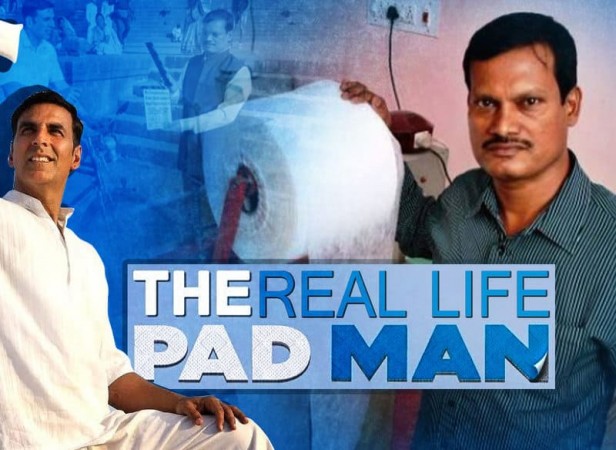
The moving tale of Arunachalam Muruganantham, a real-life inventor who transformed menstrual hygiene for women in rural India, was made public by the 2018 Bollywood film "PadMan." The sanitary-napkin machine, a life-size replica of the actual invention by Mr. Muruganantham himself, serves as a central motif in the movie. In this piece, we examine the specifics of this amazing device, its importance, and the production method used to bring it to the big screen.
Understanding the man who created the invention is crucial before delving into the actual machine. Arunachalam Muruganantham, a social entrepreneur from Coimbatore, Tamil Nadu, has devoted his life to resolving a pressing problem: the lack of access to affordable, hygienic menstrual hygiene products for women in rural India. His journey began when he learned that because sanitary napkins were so expensive, his wife had been using rags for her periods.
Mr. Muruganantham set out on a mission to develop inexpensive sanitary napkins that would give women better menstrual hygiene options. He was motivated by a strong sense of purpose. His quest was all the more amazing given that he had no prior engineering training. He persisted in the face of ridicule and social exclusion, eventually creating a straightforward, affordable sanitary-napkin machine.
The sanitary-napkin machine, which automates the manufacturing of sanitary pads, is the centrepiece of Mr. Muruganantham's invention. Millions of women's lives in India and beyond could be drastically changed by this reasonably straightforward yet brilliant device.
Design and Usability: The sanitary napkin maker is made up of a few essential parts, such as a wood pulp feeder, a cotton layer unit, and a sterilisation unit. Together, these elements help to create high-quality sanitary pads from raw materials. Even semi-skilled operators can operate the machine successfully thanks to its user-friendly design.
Affordability: The machine's affordability is one of its biggest benefits. Many entrepreneurs and NGOs cannot afford the hundreds of thousands of dollars required to purchase traditional sanitary napkin manufacturing equipment. Mr. Muruganantham's machine, on the other hand, is a game-changer for small-scale production because it is only a fraction of that price.
Hygiene and Quality: These two factors were given top priority in the design of the machine. It makes certain that sanitary pads are manufactured in accordance with the required quality standards and are free of contaminants, which is essential for promoting menstrual health.
The ability of this invention to strengthen local communities is perhaps its most significant feature. The device lessens the need for centralised manufacturing and distribution, which can be logistically challenging in rural areas, by supplying a method for local production.
Because of the significance of Mr. Muruganantham's invention, the 'PadMan' filmmakers chose to include a life-size replica of the sanitary-napkin machine in the film. Not only was this choice made for the movies, but it was also made to honour the real-life trailblazer and promote menstrual hygiene awareness.
Accuracy and Realism: To make sure the replica machine was as accurate and realistic as possible, the production crew worked closely with Arunachalam Muruganantham. They painstakingly studied the structure and operation of the original machine, and faithfully reproduced every component.
Replica machine: The replica machine served as an educational tool, assisting the audience in comprehending both the complexity and simplicity of the innovation. It illustrated how Mr. Muruganantham's invention has the potential to change the lives of millions of women.
'PadMan' served as a platform for advocacy as well as being a Bollywood film. The replica machine served as a symbol for the film's overarching message, which stressed the importance of eradicating the stigma associated with menstruation, promoting menstrual hygiene, and encouraging transformative innovations.
It took considerable effort to build a life-size replica of the sanitary-napkin dispenser. To ensure that it accurately represented Mr. Muruganantham's invention, it took a lot of time and attention to detail.
Design and engineering: The replica machine's precise design was the first step in building it. To do this, it was necessary to speak with Mr. Muruganantham and his team to fully comprehend the original machine. These details were then used by engineers and designers to produce thorough blueprints.
Finding the right materials and building the machine presented the next challenge. To build the replica, the production team used technicians and skilled craftsmen. To make it look as real as possible, they used a combination of wood, metal, and other materials.
Functionality: It was crucial to make a copy of the machine that not only looked the part but also performed similarly to the original. The replica had to be capable of performing simple tasks like feeding cotton and wood pulp, pressing, and sterilisation, which was the responsibility of skilled engineers and technicians.
Integration with the Film: Once the replica machine was finished, it needed to flow naturally into the plot of the movie. To ensure that the machine played its role in the storytelling process effectively, the production team, actors, and director had to work together.
The sanitary-napkin machine that appears in the movie "PadMan" is more than just a prop; it serves as a symbol of the strength of creativity, perseverance, and the potential for change. Everyone can be inspired by Arunachalam Muruganantham's story of rising from modest beginnings to become a leading voice in the world for menstrual hygiene. The film's replica machine serves as a physical representation of his legacy, highlighting the significance of addressing menstrual hygiene issues and encouraging advancements that can improve the lives of women all over the world.
Rishi Kapoor's Surprising Transformation: From Romantic Hero to Villain in 'Kal Kissne Dekha'
Mumtaz Askari's Journey from Skepticism to Stardom in 'Loafer' (1973)
'Flash Forward' and Its Transformation into 'Action Replayy'